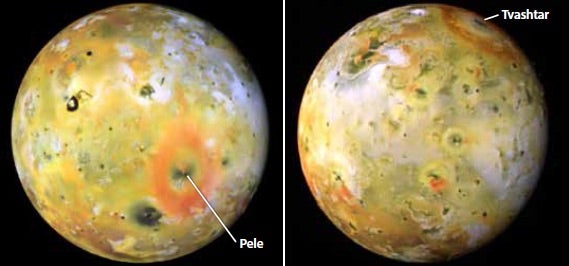Much of the material spewed from Io’s volcanoes never leaves the moon’s gravitational influence. Instead, it falls back to the surface, creating rings of material that circle Io’s volcanoes, such as those that appear around Pele and Tvashtar Catena in these Galileo spacecraft images.
NASA/JPL/University of Arizona
Yes, Io is losing mass because of its volcanic activity, but not as much as you’d think. Several of Io’s volcanoes spray gas and particles high above the surface, but most of that material falls back down to the surface, creating colorful and bright ring deposits. However, some material does eventually escape the influence of Io’s gravity and enters Jupiter’s. This material may stay in orbit around Jupiter as part of the Io Plasma Torus, a ring of electrons and ions produced by Io and heated by Jupiter’s magnetic field as it rotates.
Results from the Galileo spacecraft show that the total mass loss rate from Io is about 2,200 pounds (1,000 kilograms) per second. At this rate, the total mass lost by Io over the lifetime of the solar system is about 7×1020 pounds (3×1020 kg). This is 0.33 percent of Io’s total mass. So only a tiny percentage of Io’s mass will disappear over the lifetime of the solar system, leaving the moon intact as the Sun and the solar system age.
Julie Rathbun
Senior Scientist, Planetary Science Institute,
Claremont, California










